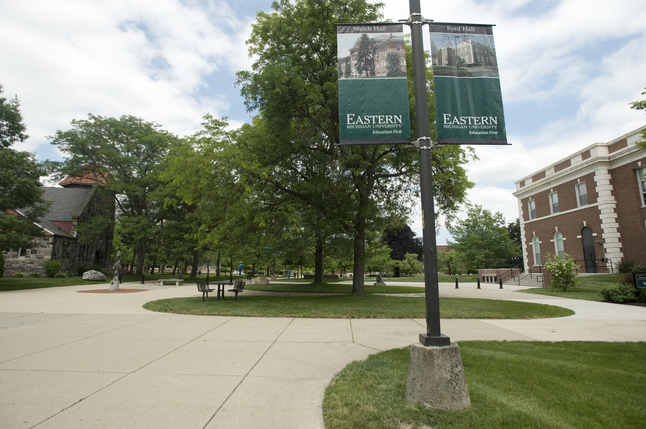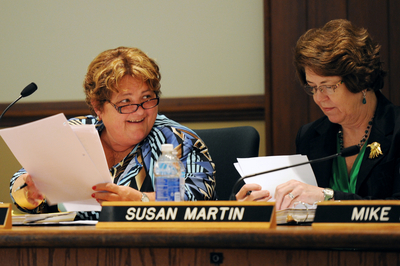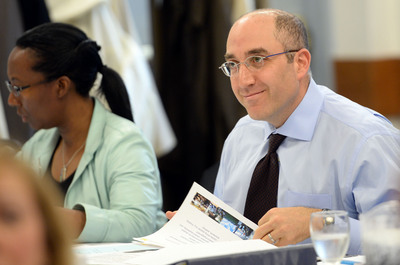Michigan universities struggle for balance between revenue and tuition costs

Eastern Michigan University's campus on Tuesday, June 18.
Melanie Maxwell | AnnArbor.com
For university governing boards, striking a balance between containing college tuition and growing revenue to pay for increasing expenses is a delicate matter — and one that is under a microscope as the nation takes a critical eye to what the U.S. president calls skyrocketing college costs.
Eastern Michigan University increased in-state tuition 3.75 percent on Tuesday, bringing the cost of a full-time education at the Ypsilanti school to $9,364 per year. That's a 66 percent cost increase from a decade ago.
The University of Michigan charges in-state students $12,994 a year and will decide on a tuition increase Thursday. In-state students are paying 63 percent more to go to U-M now than they did a decade ago. Out-of-staters pay $39,122, or 58 percent more than 10 years ago.
On Friday, Michigan State University's governing board is expected to approve a 2.8 percent tuition increase, bringing the in-state rate to $12,683 per year.
As U-M's eight-member governing board pours over the school's fiscal 2013-14 budget, it's grappling over how minimally it can raise tuition and maintain a growing academic enterprise, pay for faculty salary increases and fund construction activity that averages $523 million a year over the past decade.
"I think it is expensive to go to college, whether you're in-state or out-of-state. You can't price yourself out of the middle class. You just can't do that. That's not what we're about," U-M regent Andrea Fischer Newman said in a March interview.
Tuition is not the only factor in covering costs — U-M and EMU are looking at cost containment efforts and operating efficiencies, U-M is about to embark on a multibillion-dollar fundraising campaign and both institutions receive state funding— but it is a significant one.
In an interview Tuesday, EMU Board of Regents chair Francine Parker said EMU's 3.75 percent tuition increase — which hits the tuition increase cap outlined by the Michigan Legislature in its recent higher education budget — is necessary to pay for campus improvements.
"We've looked at restructuring our programs, we've reduced overall our operating costs, so while it's an increase there are really things that the increase is going to bring to help us, not only in assisting our current programs, but also some of the new things we're getting," Parker said. "I think anybody who comes on campus sees where the dollars are going. It makes it better for the generation that follows them."

Eastern Michigan University Board of Regents chair Francine Parker and President Susan Martin during a June 18, 2013, public meeting.
Melanie Maxwell | Annarbor.com
Parker said she and the board would have liked to authorize a higher tuition increase, but did not want to be financially penalized by the state. If the school went above the legislature's 3.75 percent cap, it risked losing some of its $66.5 million in state funding.
EMU regents also approved a $296.4 million operating budget on Tuesday.
The new makeup of U-M's governing board — which includes two new Democratic regents elected in November — could lead to one of the more modest tuition increases in recent history.
Last year, a 2.8 percent increase passed in a 5-3 vote during a June meeting. The three regents who voted against the increase — Andrea Fischer Newman, Denise Ilitch and Larry Dietch — remain on the board. Meanwhile, two of the regents who supported the increase have since retired from the board. They've been replaced by Mark Bernstein and Shauna Ryder Diggs, both Democrats elected in November.
Bernstein, of Ann Arbor, said during the election he would have voted against the 2012 tuition increase. Diggs, in an October interview, did not say whether she would have voted against the increase but said the school needed to "hold costs or decrease costs."
All eight U-M regents did not respond to, or declined, requests for comment on this article.

University of Michigan regent Mark Bernstein, elected to the Board of Regents in November, said he would have voted against last year's 2.8 percent tuition increase.
In past years tuition increases for out-of-state students have been larger than increases for in-state students. Despite the increase in non-resident tuition, the number of applications from out-of-state continues to grow. Regents could decide to leverage out-of-state tuition as a way to keep in-state tuition low. Yet doing so will require a strategy to enroll socio-economically diverse out-of-state students. The vast majority of U-M's non-residents are wealthy.
U-M regents will discuss fiscal 2013-14 tuition rates during a public meeting Thursday at 3 p.m. in the Michigan Union on the school's Ann Arbor campus.
In 2012, U-M had the second-most expensive in-state tuition rates in Michigan, after Michigan Technological University. EMU had the third-lowest tuition rate of the state's 15 public universities.
Meanwhile, Western Michigan University increased its 2013-14 resident tuition to $10,355, Central Michigan University 's 2013-14 tuition is $11,220, Ferris State University's tuition is $10,950 and Saginaw Valley State University increased next year's tuition to $8,423.
Correction: An earlier version of this article said U-M has spent an average of $523,000 a year on construction. The correct figure is $523 million. Kellie Woodhouse covers higher education for AnnArbor.com. Reach her at kelliewoodhouse@annarbor.com or 734-623-4602 and follow her on twitter.


Comments
NorthMaple
Thu, Jun 20, 2013 : 4:22 p.m.
5th paragraph: the term is to "pore over," not to "pour over." http://www.merriam-webster.com/dictionary/pore
Roger Kuhlman
Thu, Jun 20, 2013 : 3:36 p.m.
When are Michigan universities going to begin to control their costs. The gravy train for staffs and administrators has got to end. Students of modest means can not afford the prices these universities are charging!
Roger Kuhlman
Fri, Jun 21, 2013 : 2:05 p.m.
I would bet most staff members at UM get far better benefits and pay than their counterparts in the private sector. That is not fair or right I do agree there are variations in the gravy. Some at UM are real hogs.
Ignatz
Thu, Jun 20, 2013 : 4:40 p.m.
Roger, That gravy is pretty thin for the vast majority of staff.
Geoff Larcom
Thu, Jun 20, 2013 : 2:06 p.m.
"In 2012, U-M had the second-most expensive in-state tuition rates in Michigan, after Michigan Technological University. EMU had the third-lowest tuition rate of the state's 15 public universities." This is a meaningful statement as it pertains to Eastern Michigan. Over the last five years, EMU has had the lowest dollar increase in tuition of any of Michigan's 15 public institutions. This effort at tuition restraint and helping students afford college has occurred despite historic cutbacks in state funding. At the same time, EMU has continued to invest in key academic facilities such as the Science Complex and Pray-Harrold classroom building, along with residence halls, IT infrastructure and classroom technology.
Real Life
Thu, Jun 20, 2013 : 1:18 p.m.
Accountability in higher education has gone out the window. Tuitions are twice where they ought to be, especially given the quality and content of the curriculum. The universities' costs have been out of control for decades, and they have not been good stewards of the public trust. They need to divest their holdings and cut back on bloated staffs. Only higher ed and medical care have outpaced inflation in our economy, and by a great deal. It's high time we go to the root causes.
blue85
Fri, Jun 21, 2013 : 1:08 a.m.
The below contains lots of slogans, but where is the analysis? 1) "Accountability in higher education has gone out the window." How do you measure accountability? What was the measure of accountability at the roughly 4,000 national schools and how has it changed over the last decade? 2) "Tuitions are twice where they ought to be, especially given the quality and content of the curriculum. " Where should tuition levels be, given inflation, cuts in state aid, changing cost structures, changing knowledge pools,changing curricula? How do you measure quality? Dollars are one unit of measure, but quality does not have a numeric basis. Utility theory has defeated 10 generations of economists...do you have a solution as to how to match those bases? 3) "The universities' costs have been out of control for decades, and they have not been good stewards of the public trust. " UM tuition increases match almost exactly the rise in inflation and the decrement in state funding. Given that fairly precise match, how has your trust been lost and where is the failure? 4) "They need to divest their holdings and cut back on bloated staffs. " Why should "holdings" be divested? What are holdings? Should they sell their cash for...cash? Should they sell their buildings? Why do you want to convert public assets to private assets? Are you prepared to offer the high bid? To what extent are staffs bloated? How large should they be at each school? How do you measure headcount efficiency? 5) "Only higher ed and medical care have outpaced inflation in our economy, and by a great deal. It's high time we go to the root causes." Without researching it, since you've made the assertion, what are those respective levels, their cost drivers, and what are alternative cheaper cost drivers and who is putting those drivers on offer at a lower level? If there are cheaper drivers, why are schools over paying?
nekm1
Thu, Jun 20, 2013 : 12:53 p.m.
How about one president for every 2 or 3 State Universities, and put the saving back into the general tuition fund?
slave2work
Thu, Jun 20, 2013 : 12:14 p.m.
Hard to feel sorry for them when they pay football coaches and aides, and other coaches too.. so much money, I don't care where that money comes from it can be used to run the U. I agree with John B.. buy somemore land and buildings.. state funded U's ..need more oversite.. Take our money and run.
Rich
Thu, Jun 20, 2013 : 3:06 p.m.
I'm pretty sure the $523 million (per year!) spent on buildings is more of a problem than the football coaches $3 million salary
UloveM
Thu, Jun 20, 2013 : 12:13 p.m.
The University of Michigan charges in-state students $12,994 a yea, is only for the LSA, freshmen. For the seniors at engineering school, they were billed at a much high rate. Tuition 01/09/2012 8636.00 Tuition 09/04/2012 8884.00 Fees 01/09/2012 80.00 Fees 09/04/2012 80.00
RUKiddingMe
Thu, Jun 20, 2013 : 12:03 p.m.
The universities need a rigorous looking at the way everyone was looking at the car companies a while ago (oooh, those greedy jerks taking their personal jets to the congressional hearing!). The (deserved) vitriol directed at Wall Street and car companies is for some reason absent from the university and health care industries, but they are doing the same thing.
John B
Thu, Jun 20, 2013 : 11:15 a.m.
Your kidding, right. University of Michigan has been buying up and building on land in Michigan for the past 40 years (or more), hardly seems like a struggle for revenue. You want to see a struggle, take a look at my balance sheet.
sellers
Thu, Jun 20, 2013 : 11:33 a.m.
It's a matter of what money is used where. Certain monies can only be used for certain projects.
ChelseaBob
Thu, Jun 20, 2013 : 10:53 a.m.
Tuition increases at roughly twice the rate of inflation while the return on this investment for many degrees is poor. This is a recipe for falling enrollment as students finder more cost effective education alternatives in the years ahead. I'll bet, however, that most Michigan universities are projecting increased enrollment in budget planning. Guess where that will put us in 10 years? Bankrupt universities and another crisis.
blue85
Sat, Jun 22, 2013 : 1:42 a.m.
"Blue85- What does your reply have to do with comment?" Why do you need me to parse that out for you: 1) I included your quote for ready reference; 2) you state that tuition is moving at twice the rate of inflation, I address the issue of two types of inflation; 3) I note that your analysis is incorrect in that the only driver is not inflation, but also state cuts. What am I missing about what you are missing about what I am saying? I didn't respond to your other points, but you asked so here are a few points: 1) ROI is not the only measure for the value of a degree...running universities like trade schools is a relatively new notion and one I find to be an unconvincing model; 2) yes, there may be alternatives, but it remains to be seen if they will be cost effective, or if UM, a premium product, will suffer...in fact applications continue to skyrocket; 3) as to your bet about increased enrollment, I don't know about that, no do I venture to guess, do you; 4) some schools go bankrupt every year...I'll wait until I see your analysis as to the drivers and the increase in the rates going forward.
ChelseaBob
Fri, Jun 21, 2013 : 8:32 p.m.
Blue85- What does your reply have to do with comment?
blue85
Fri, Jun 21, 2013 : 12:59 a.m.
"Keep your eye on the budget which still increased at twice the rate of inflation." http://inflationdata.com/Inflation/Consumer_Price_Index/HistoricalCPI.aspx?reloaded=true (229.594/183.96)^(1/10)=2.24% for CPI https://cfo.asu.edu/budget-higher-education-price-index-hepi-history (293.2/223.5)^(1/10)=2.75% State Aid http://online.wsj.com/article/SB10001424127887323501404578163290734542674.html At the University of Michigan, state funding has fallen 26% in the past decade. The state now covers 17% of the university's budget, down from 33% in 2002-03. Amounts to a decline of 3.01%/year To summarize, the rate of inflation in CPI has been 2.24%, the rate of inflation in the higher education index has been 2.75%, and the decline in state aid has been 3.011%. Adding the CPI (conservative) to the decline in state aid, we get an annual figure of 5.25% versus an increase of ($13,142/$7,975)^(1/10)=5.12% In sum, while you have repeatedly tried to make the point that the cost growth is twice the rate of inflation, it is, while in fact roughly twice the rate of inflation, your calculation doesn't take cognizance of state funding shortfalls. Taking cognizance of those short falls produces a nearly perfect prediction method: add the rate of state funding shortfalls to the rate of CPI and you arrive at the annual increase in tuition. What your post also misses is that for most families under $80,000 in annual income, it is cheaper to go to UM today than it was 10 years ago.
DennisP
Thu, Jun 20, 2013 : 10:41 a.m.
"Regents could decide to leverage out-of-state tuition as a way to keep in-state tuition low. Yet doing so will require a strategy to enroll socio-economically diverse out-of-state students." I find that an interesting statement. Why does a state institution need a strategy to enroll economically diverse out-of-state students? If economic diversity is important, it's origin is irrelevant. We have plenty of economically challenged families throughout the State. The UM has no obligation to any out-of-state group or class. That's what public institutions and state institutions are for. To educate their own citizenry so as to promote growth and future development. As it stands, enough UM students leave the State upon graduation. So now the UM needs to subsidize others to come, get an education, then leave? It is a luxury for out-of-state and foreign students to come to the UM while there are thousands of other options in all 50 states and throughout the world.
trespass
Thu, Jun 20, 2013 : 10:32 a.m.
"fund construction activity that averages $523,000 a year over the past decade." I believe that is $523 million a year. You need to watch those pesky decimal points. That is almost equal to the in state tuition rate per student per year. This is like the old Roman Emporers who built monuments as their legacy. I think President Coleman sees this construction as her lasting legacy at UM.
Kellie Woodhouse
Thu, Jun 20, 2013 : 2:30 p.m.
Ack! Thank you for pointing out my error. I am appending a correction to the article.
Steve Hendel
Thu, Jun 20, 2013 : 10:17 a.m.
The piece is informative, but the headline makes no sense.